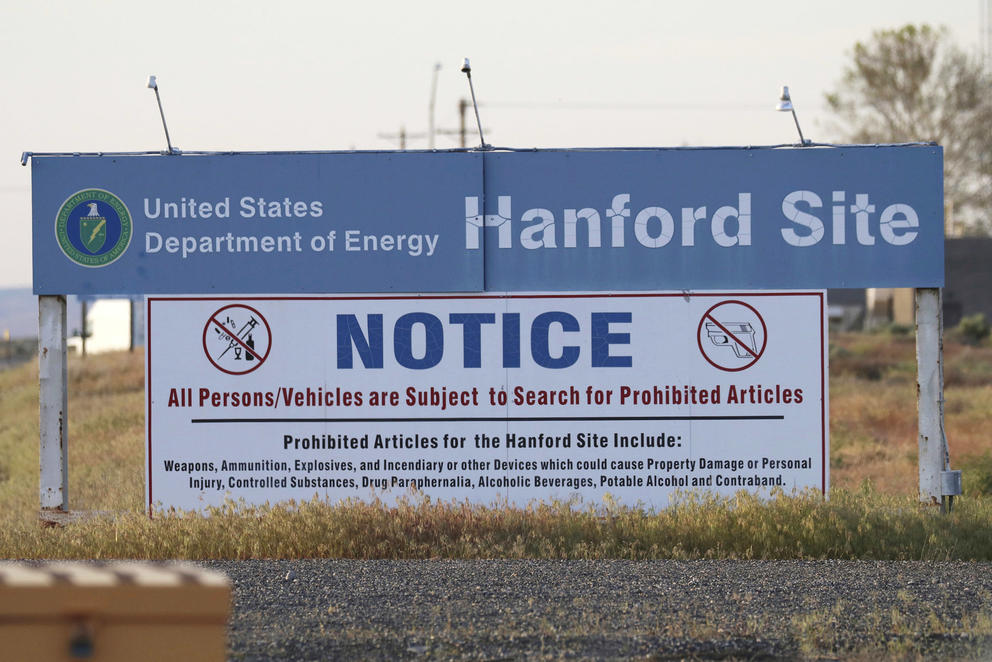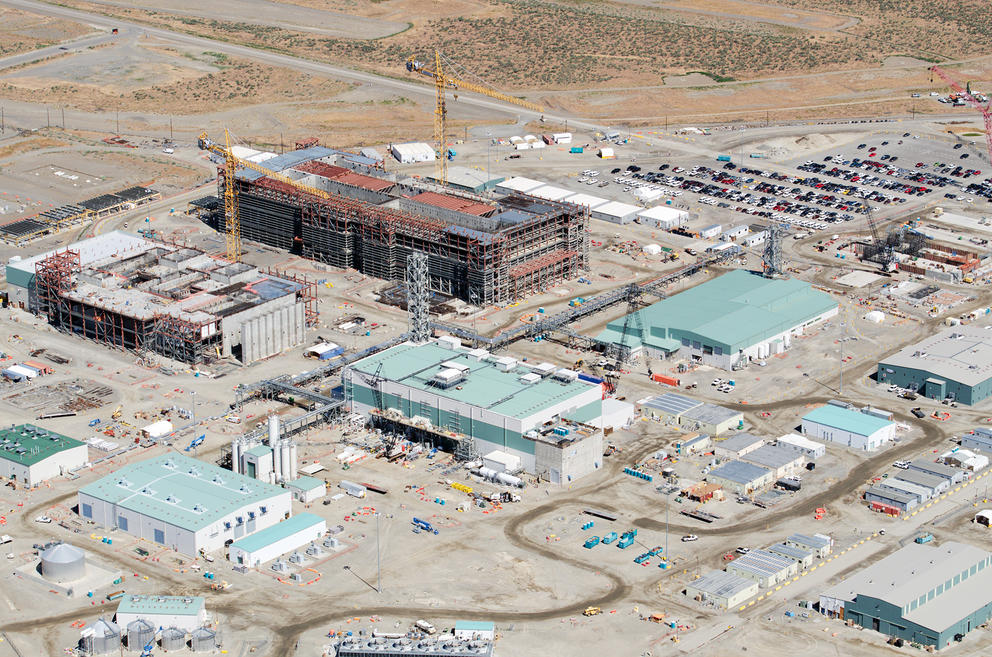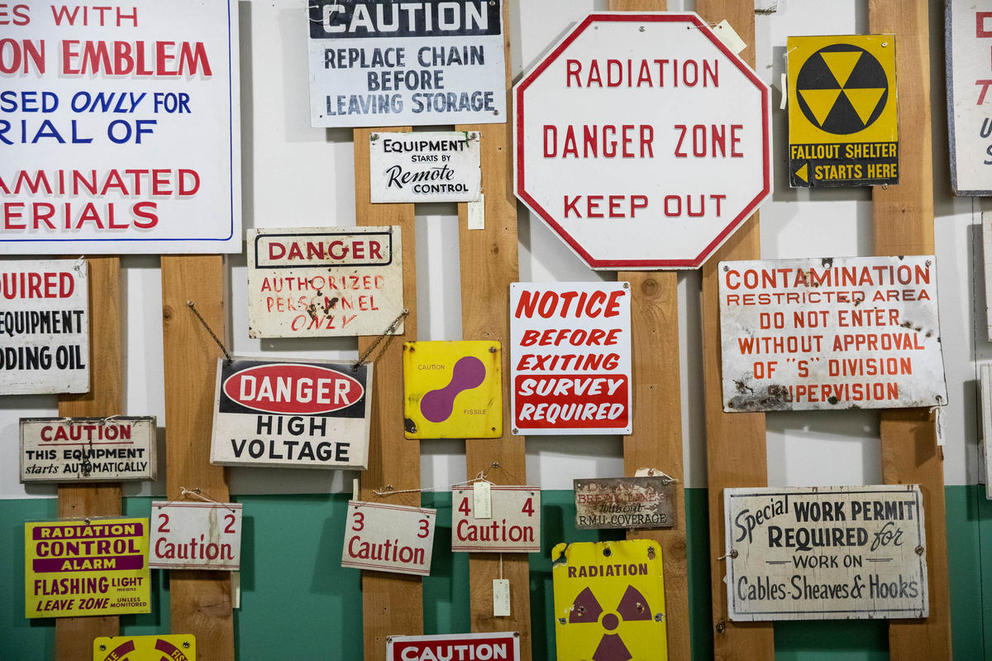Now the federal government and some Tri-Citians are wondering whether one of the three proposed glassification plants can be replaced with an alternative approach — mixing at least 40 percent of those 56 million gallons of radioactive fluids and chunks into a type of cement. The plan would involve shipping this “grout” out of state.
Could decades be chopped off a Hanford cleanup schedule that constantly creeps toward the end of the 21st century by adopting this grouting plan? Could tens of billions of dollars be eliminated from a budget that is always growing? Will grouting increase the danger of highly radioactive substances seeping into the ground? Does anyone actually know how to safely mix Hanford’s tank wastes with grout?
The U.S. Department of Energy, which is in charge of Hanford, has approached the state of Washington about grouting a huge portion of Hanford’s tank wastes, said David Bowen, nuclear waste program manager for the Washington Department of Ecology. But he stopped short of confirming that grouting is a topic in secret negotiations between the state and the federal government.
The DOE and Washington’s Department of Ecology have been in secret talks for three years to discuss major changes to Hanford’s cleanup timetable and standards. Both sides have agreed not to reveal to the public what is being discussed. Neither side will speculate on how long these secret talks will continue before agreements will be reached and shared with the public.
Hanford observers believe grouting has inevitably been a subject of those talks.
“I’ve gotta believe grouting is that part of that conversation, a big part of the conversation,” said David Reeploeg, who handles Hanford issues for the Tri-Cities Industrial Development Council and Hanford Communities. Both Tri-City organizations are deeply involved in Hanford matters.
“I think [the grout-versus-glassification talks] will determine the future of cleanup,” said Nikolas Peterson, executive director of Hanford Challenge, a Seattle-based Hanford watchdog organization.
DOE does not want to discuss on the record the possibility of using grout. On background, it acknowledged that grout is being considered as a potential replacement for one of the three glassification plants, but added that any decision will be made sometime in the future. DOE provided Crosscut with some reports on glassification and grouting.
Hanford is arguably the most radioactively and chemically contaminated spot in the Western Hemisphere. The U.S. government set up Hanford in 1943 to create plutonium for the nation’s atomic bombs, including those exploded in New Mexico and over Nagasaki in 1945. These processes created many billions of gallons of chemical and radioactive wastes, the worst 56 million gallons of which were pumped into 177 underground tanks. About a third of those tanks leak. At least a million gallons of radioactive liquid has leaked into the ground, seeping into the aquifer 200 feet below and then into the Columbia River, roughly seven miles away.
In the early 1990s, state and federal officials decided tank waste should be mixed with glass flakes and melted together so the radioactive substances cannot escape for 10,000 years. About 90 percent of tank wastes are dubbed “low-activity,” and the remaining 10 percent are radioactive at a “high level.”
The original $4 billion glassification plant was supposed to be ready by 2009, but both budgets and deadlines have been busted several times in recent decades. Originally, that legal deadline to complete glassification was 2019. Currently, Hanford’s legal target calls for glassifying all wastes by 2052. DOE has moved those targets back to 2069 — a date not reflected in its current legal cleanup agreements with the state of Washington, according to a 2021 report by the Government Accountability Office.
A 2020 DOE report also said glassification might be completed by 2069 at the earliest, while looking at several other scenarios in which glassification could extend into the 2070s. The year 2069 is 50 years beyond the original glassification completion deadline of 2019.
Today, the project’s official budget is at least $17 billion. So far the federal government has spent $13 billion on the glassification project, according to the Government Accountability Office, the investigative agency of Congress. A June 2022 GAO report has estimated that the current $17 billion estimate will increase to between $33 billion and $42 billion for this project.
It is estimated that the first low-activity-waste glassification plant will handle only 40% to 50% of the low-activity wastes, depending on who is doing the estimating. That translates to no more than 25 million of the 56 million gallons of tank waste.
The federal government has yet to release a detailed plan for the high-level and second low-activity waste plants, including when the work is expected to be completed.
This is where grout enters the picture.
In 2017, June 2022 and July 2022, the GAO issued reports strongly recommending that the DOE look at replacing the second far-in-the-future low-activity-waste glassification plant with a plan to grout the roughly 25 million gallons of waste (50 percent of 90 percent of the 56 million gallons in total waste) not covered by the first low-activity plant.
The July 2022 GAO report presented the following estimates:
* Hanford’s glassification budget for 2022 is $861 million. The estimated need for 2023 is $2.1 billion. This will increase to $3.7 billion in 2029. The DOE predicted in 2019 that this big glassification budget hike would be needed.
* Hanford will need to spend $28 billion to go full-tilt on a second low-activity-waste plant and high-level-waste glassification through 2032. Grouting an extra 25 million gallons in tank waste should cost $12 billion from 2023 to 2032. However, the GAO report does not take into account that Hanford is not at all prepared to begin grouting in 2023.
The GAO report does not mention how long grouting would have to continue beyond 2032.
Also in its December 2020 report to Congress, the DOE said up to 80% of Hanford’s tank waste could be converted into cement-like grout — skipping the whole glassification process. Grouting that much waste could save $73 billion to $210 billion over an unspecified period of time, the report said. The DOE’s report does not say how the $210 billion savings estimate was calculated. The department has not publically mapped out budgets or schedules for setting up a grouting system, and the technology is not nailed down.
Retired Tri-City Industrial Development Council Hanford leader Gary Peterson and Reeploeg argue that glassification’s costs and timelines have grown so much that grouting is needed to bring the entire project within a manageable budget. Reeploeg said: “Budget realities are significant factors. What keeps me up at night is the long-term costs.”
Gerry Pollet, executive director of the watchdog organization Heart of America Northwest and a state legislator from Seattle; other state officials; Reeploeg; and Peterson all noted that all 177 of Hanford’s underground tanks have exceeded their designed lifespans. Twenty-eight of the 177 tanks are double-shelled, meaning they are safer and less likely to leak, but so far, one of them has.
This leads to another budget pressure.
Northwest interests want the DOE to build new double-shell tanks. It would take seven years and $1.5 billion to build four million-gallon double-shell tanks, the GAO reported. However, the DOE contends it can start glassifying wastes at a fast-enough rate to avoid the necessity of building more double-shell tanks.
Meanwhile, the two waste-and-glass melters in the first low-activity-waste plant are expected to last five years, according to the DOE. Then it will take several months of remote-control work to replace a burned-out melter. This adds pressure to stick to the agreed-on legal timetables.
TRIDEC’s Peterson, Reeploeg and Pollet all noted that glassification will require massive amounts of water to be added to the wastes, which will lead to significant volumes of extra secondary wastes to be processed outside of the melters. That extra waste likely will have to be treated separately and buried at Hanford. A 2020 DOE report on this subject looked at several glassification scenarios, and estimated the additional water might increase the volumes handled in the first low-activity-waste plant by 15 percent to 600 percent, depending on the technical circumstances.
“It’s this dirty little secret. Put one gallon of [radioactive waste] into the vit plant and get [several] gallons of extra wastes,” Pollet said. Vitrification is the technical name for glassifying tank wastes, and Hanford’s complex is commonly called “the vit plant.”
The main problem for the state ecology department, Heart of America and Hanford Challenge is that grouting low-activity radioactive wastes has not been studied substantially as a way to deal with Hanford’s wastes. The DOE has noted, however, that it has used grout to deal with radioactive wastes in underground tanks at its Savannah River, S.C., site. The basic science and engineering has been around for decades, said Matt Rasmussen, a grouting expert with the Pacific Northwest National Laboratory.
But Suzanne Dahl, the state’s tank-waste treatment manager, along with Peterson and Pollet, has noted that Savannah River’s radioactive tank wastes have a much simpler radiological and chemical composition than Hanford’s. The waste at Hanford contains at least 100 chemical and radioactive substances, meaning numerous chemical engineering factors need to be studied.
Bowen said the GAO reports that support grouting lack details and indicate the faster schedules and cheaper budgets are possibilities, not guarantees. “When [a report] says ‘maybe, could, probably,’ that means more analysis is needed,” Bowen said.
The National Academy of Sciences is studying this issue, but has issued no reports beyond saying this matter needs to be analyzed in depth.
“At this point, we haven’t seen a magic form of grout, but they are working on it,“ Dahl said.
The bottom line for the state ecology department is that any grouted tank wastes — even if shipped elsewhere — must be as effective as glassification in preventing radioactive substances from escaping.
An experimental grouting project is now underway at Hanford. A company called Perma-Fix is experimenting with mixing low-activity tank wastes with grout to be shipped to an existing Texas low-level radioactive-waste dump site.
So far Perma-Fix has done one test run, in 2017, with three gallons of tank waste, successfully trucking that small sample to a mixed-waste dump in Texas. The second test run, involving 2,000 gallons, is on hold pending completion of the secret talks between the DOE and the state Ecology Department. Meanwhile, the state would want multiple bidders for any grouting contract, if it agrees to that scenario.
The DOE’s December 2020 report to Congress says that 80 percent of Hanford’s tank wastes could be grouted, but that figure includes reclassifying a significant amount of Hanford’s high-level wastes (10 percent, or 5 to 6 million gallons) to low-activity wastes.
The state ecology department is dead-set against such a reclassification. Reclassifying a significant amount of high-level waste as low-activity waste is key to reaching 80%, the report said.
In a 2021 letter, Washington’s ecology department and attorney general’s office wrote: “We believe this … lays the groundwork for the [DOE] department to abandon significant amounts of radioactive waste in Washington state precipitously close to the Columbia River.”
In emails to Crosscut, DOE’s Richland office said reclassifying high-level wastes is not being considered.
However, Hanford Challenge’s Peterson believes the temptation to reclassify high-level wastes won’t go away if grouting remains on the table. He noted the 2020 DOE report to Congress said 80 percent of Hanford’s 56 million gallons of radioactive wastes can be grouted if some of the high-level wastes are reclassified. “What’s to stop DOE from grouting everything?” Peterson said.
A key difference between grouted tank waste and glassified waste is where it will end up.
Glassified low-activity tank wastes are destined to be buried at Hanford. However, the state is insistent that any grouted low-activity wastes be shipped offsite for burial — adding the caveat that any such wastes must be as secure from breaking down as glassified wastes. Washington does not want the less-secure tank wastes to break down in another state, Dahl said.
The only two spots in the United States capable of handling grouted tank wastes from Hanford are an EnviroCare site in Clive, Utah, and a Waste Control Specialists site in Andrews County, Texas. These sites are not over aquifers, while Hanford is on top of a huge aquifer leading to the Columbia River. The possibility of grout being unable to contain radioactive substances for as long as glass does has made the state leery about storing grout for thousands of years above an aquifer.
Beyond the three gallons of grouted wastes shipped to Texas in 2017, DOE has not approached Texas and Utah about accepting grouted Hanford wastes, said spokespeople for the two states’ environmental departments. Any Hanford wastes shipped to Utah or Texas would have to meet those state’s safety regulations.
Meanwhile, more budget pressures have recently mounted at the DOE — which could affect the three-year-old secret talks with the state and into any decisions on grouting.
On Aug. 22, Washington Gov. Jay Inslee and Oregon Gov. Kate Brown sent a letter to President Joe Biden to request massive annual budget increases for Hanford’s cleanup. Co-signers include TRIDEC, Hanford Communities Hanford Challenge, and other environmental and Tri-Cities interests.
The letter addressed most Hanford cleanup issues, including dealing with the tank wastes. Other cleanup matters include decontaminating huge buildings, cleaning up contaminated groundwater, and dealing with many types of containers of other radioactive wastes.
DOE estimates that $300 billion to $640 billion will be needed to finish all of Hanford’s environmental cleanup by 2078. That translates to annual budgets of $5.4 billion at the low end of the estimate to $11 billion at the high end, according to DOE's 2022 Hanford LIfecycle Scope, Schedule and Cost Report. Again, this year’s overall cleanup budget is $2.6 billion.
"Importantly, this large volume of tank waste presents one of the most significant long-term risks at Hanford, and tank waste treatment is the largest cost driver for the entire cleanup effort," the letter said.
In an August visit to the Tri-Cities, U.S. Energy Secretary Jennifer Granholm said the results of the unresolved secret talks will determine how much extra money DOE will request for Hanford.
“If we want to get this project done by the end of the century, we need funding at the level we are asking for,” Bowen said.





